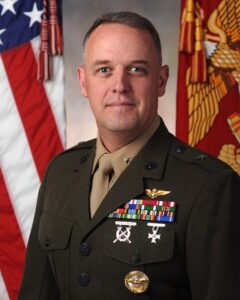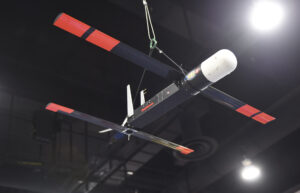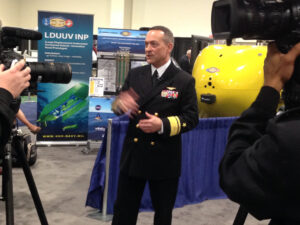Learning From Termites: Navy, Marines Seek New Breed Of Drones
Posted on
NATIONAL HARBOR: Navy Secretary Ray Mabus may want to move drones to the top of his priorities, but what kind of unmanned systems do the Navy and Marine Corps want to buy?
Don’t think Predator or even the Navy’s new 131-foot-wingspan Triton. Imagine a swarm of buzzing, scuttling or swimming robots that are smaller but smarter. While a human has to fly the Predator by remote control, these systems would make decisions and coordinate themselves without constant human supervision — perhaps without any contact at all.

Brig. Gen. Kevin Killea
“The key here is how those systems will communicate,” said Brig. Gen. Kevin Killea, head of the Marine Corps Warfighting Laboratory in Quantico. “For swarming to work, I don’t think we can be dependent on the RF [radio frequency] spectrum…. We’re seeing more and more every day that that’s vulnerable” — to jamming, to hacking, even to bad weather. “We can’t go down the primrose path that we’re on with dependence on RF spectrum,” he said. Future swarming systems need to be able to operate when communications links are erratic or lost, not just between the robots and their human masters but even between one robot and the next.
With direct communications cut off, Killea said, each member of the swarm has to be able to observe its environment — its fellow robots, the enemy, friendly manned systems, humans — and act. What’s more, all the swarmbots need to think enough alike that the same environmental cues will cause them to react in the same way, achieving coordination without communication.
“That’s kind of like how termites work,” Killea said. “Without communicating they sense the environment change around them, and they instinctively know which way to go.” A termite, ant, or other social insect will “communicate” by releasing scents that, for example, mark trails to food sources or warn of attackers; other members of the same hive then sniff the pheromones and react instinctively, heading for the food or away from danger.
“I completely agree with [Killea]: We cannot rely on RF,” said Rear Adm. Mark Darrah, the Navy’s program executive officer for unmanned aviation. But there are other ways to operate. “The albatross can fly 3,000 miles and go back to its nest,” and it’s not using a map, GPS, or radio direction-finding, he said. “It’s magnetics.”
Birds are another example of coordinating without communicating. A flock doesn’t file a flight plan or agree on a formation. Each individual bird sees what its neighbors are doing, feels the air currents, senses the magnetic field of the earth and flies. Yet all these individual decisions keep the flock together and often keep it in a specific shape, such as a V. Fish swimming together in schools operate much the same way, and they manage it with even smaller brains than birds. If herring can do it, there’s hope for robots.
Of course, no one’s going to give a herring Hellfire missiles. “Don’t get all Terminator/Sarah Connor paranoid on me here,” Killea said to laughter. “Humans must be kept in the loop, particularly with regard to use of force.”
The military doesn’t want to build autonomous robots, arm them and release them unsupervised into the world. Humans may not be “in the loop” as they are for the Predator, where they must direct every minute movement, or even as they are for the Triton, where they must choose the drone’s course. But for life-or-death decisions, humans need to be “on the loop,” monitoring the robots’ actions and able to countermand them if necessary.

The Navy’s tube-launched LOCUST mini-drone.
Being on the loop also requires less bandwidth and less constant connectivity than being in it. That makes on-the-loop control more feasible than in-the-loop when military networks are under attack. When communications are cut off altogether, however, human control is lost. For reasons like that, Killea said, “unmanned, autonomous systems may not be useful or appropriate for all missions.”
Some missions, however, may be uniquely suited to autonomous swarms operating outside human supervision. The dangerous, tedious, and time-consuming work of clearing mines, for example, would be ideal for “truly autonomous systems, operating effectively without communications under water for long periods of time,” said Rear Adm. James Morse, the Royal Navy’s procurement chief.
The real limiting factor may be less technology than imagination — and bureaucracy. “One of the points that came out of an autonomous systems conference we held last year in the UK,” Morse told the conference, “was [that] if we set on the traditional old approach to requirements setting…members of industry may have other ideas that we just haven’t thought of and we can’t exploit because we’ve set limited requirements that drive limited solutions.”
Currently, the US Navy is conducting a number of swarm experiments. Killea’s favorite example isn’t really a swarm. It was of an unmanned ground vehicle that carried a small unmanned aerial vehicle. The human operator told the robots to find an object, defined the general search area and then let them go. The UGV searched for a while without success, then autonomously decided to launch its mini-UAV partner — which spotted the target. Then, and only then, the robots reported back to the human and requested instructions.
Other experiments get much closer to the real swarm concept. Last fall, a single sailor oversaw a wolfpack of 13 unmanned boats that coordinated their own response to a simulated enemy craft. (The boats relied on conventional radio frequency communications, however, rather than coordinating like termites or flocking birds). It also has a swarm of flying drones called LOCUST, short for Low-Cost UAV Swarming Technology, which fires mini-drones into the air from a launch tube. The goal is to get 30 in the air at once sometime in 2016, said Rear Adm. Mathias Winter, Chief of Naval Research.

Rear Adm. Mathias Winter, Chief of Naval Research
Each LOCUST drone is “able to operate independently, and then come together in severable packages, and then severable packages come together form multiple severable packages,” Winter said at the conference. In other words, the drones can spontaneously form groups, the groups can spontaneously merge into larger groups, and as needed they can all split up again (hence “severable”).
That requires formidable flexibility, something computer programs are not noted for. “Today we are programming our autonomous systems to operate within very defined envelopes to ensure safe operations and completion of the mission set,” said Darrah. For example, he said, the X-47B drone lands on the same spot on the carrier deck every time. That robotic repetition is great for certain tasks, but not for things like air-to-air refueling, where the fuel hose (or drogue) trailing from the tanker is in constant motion and nothing is ever 100 percent sure.
“We’ve got to figure out how to teach it to take chances,” Darrah said. “Artificial intelligence where the machine learns and makes decisions is something we have got to get to.”
Subscribe to our newsletter
Promotions, new products and sales. Directly to your inbox.
